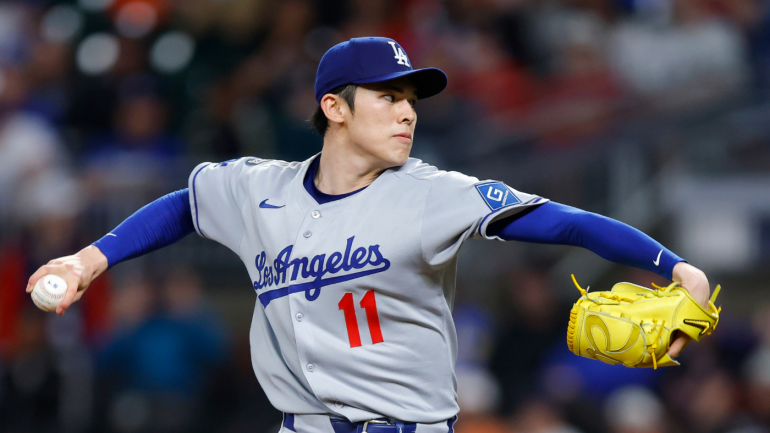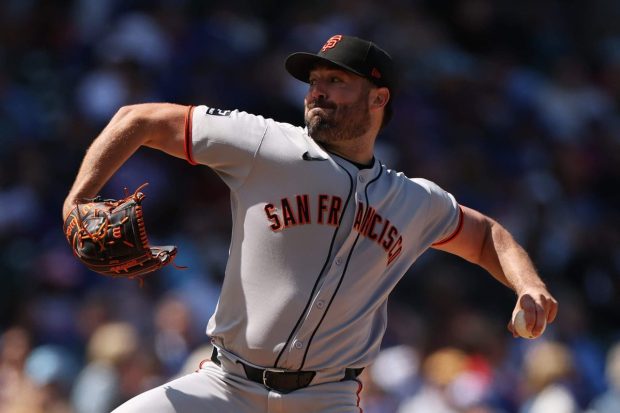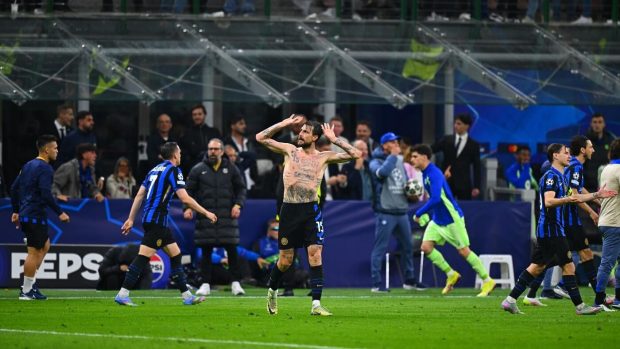

The first 20% of the 2025 MLB regular season is in the books and things are beginning to look normal, for lack of a better term. Only one qualified hitter (Aaron Judge) is hitting over .400 and just a handful of qualified starters have a sub-2.00 ERA. Contenders that started poorly are getting hot and pretenders that started well are coming back to Earth. Here now are three trends worth keeping an eye on as we head into the thick of May.
Sasaki’s not-so-great fastball
Saturday night in Atlanta, Dodgers righty Roki Sasaki earned his first MLB win with an outing that was OK but not really great. He allowed three runs on six hits and two walks in five innings, and struck out four. The offense put 10 runs on the board, including seven when Sasaki was in the game, which helped the 23-year-old righty record his first big-league W.
“Just really relieved and happy,” Sasaki said through an interpreter about getting his first win (via the Orange County Register). “I’m just relieved that I was able to do what I was supposed to do as a starting pitcher. Knowing the circumstances to which it was getting complicated as the (rain) delay was getting a little longer, and also knowing the fact that we were gonna play today.”
Seven starts into his Dodgers career, Sasaki has a 3.86 ERA and has put 44 runners on base in 30 ⅓ innings. The arm talent is obvious and the kid is electric, though like so many young pitchers, Sasaki’s had ups and downs early in his career. That includes walking 20 batters in those 30 ⅓ innings. Young pitchers walk too many hitters. It’s what they do.
The most surprising thing about Sasaki through seven starts (surprising to those who didn’t follow him closely in Japan, I should say) is that his fastball, while lighting up the radar gun, is pretty mediocre in terms of results. Sixty-eight pitchers have thrown at least 200 four-seam fastballs this season, and only one has a lower whiff rate (i.e. misses per swing) on the pitch than Sasaki:
- Antonio Senzatela, Rockies: 10.3%
- Roki Sasaki, Dodgers: 11.0%
- Mitch Keller, Pirates: 11.0%
- Jack Flaherty, Tigers: 11.3%
- Mitchell Parker, Nationals: 11.8%
(MLB average on four-seamers: 21.3%)
Sasaki’s fastball whiff rate is barely half the MLB average. Opponents are hitting .232 with a .406 slugging percentage against his four-seamer, which is better than the league average (.248 AVG and .424 SLG). That’s the average for all four-seamers though. If you look at 96 mph and above, like Sasaki’s heater, the MLB averages are .236 AVG and .405 SLG. Sasaki’s right there.
Despite the velocity, Sasaki’s fastball plays down because it has poor shape, meaning the movement characteristics of the pitch. The spin and rise on his fastball are unremarkable, making the pitch easier for hitters to track and time. Those pitch characteristics can be improved (and the Dodgers are very good at doing so), though it can take time, and sometimes things just do not click.
Also, Sasaki’s velocity is trending down. His fastball has sat closer to 94-96 mph the last three times out compared to 96-98 mph in his first few starts. Sasaki hit 100.6 mph against the Cubs in the Tokyo Series. He hasn’t throw a pitch above 98.6 mph since. Dodgers pitching coach Mark Prior indicated Sasaki is intentionally holding back on his fastball in an effort to locate better.
“Roki, everybody knows he throws 100,” Prior told The Athletic recently. “He’s not throwing 100 with us. That’s something that I think he was trying to train and get to it, which we tried to help as much as we could. But he also felt like it affected his command tremendously in those first couple outings.”
Prior also said the Dodgers and Sasaki are “kind of in bed with where we’re at” as far as his fastball shape, meaning they can only do so much in-season. Sasaki signed with the Dodgers on Jan. 22, or three weeks before spring training, give or take. That didn’t give them much time to work on things, especially with the team’s unusual ramp up to the Tokyo Series in mid-March.
There is more to life than fastball shape, but it is an important piece of the pie, and Sasaki’s underwhelms. Still, his slider and splitter are so good that he has more than enough to get by. It is likely the best version of Sasaki is a year or two (or three) away, after he can spend a proper offseason working with the Dodgers. What he is right now is still pretty good, albeit not elite.
Walker’s improved defense
In his third MLB season, the Cardinals are still waiting for erstwhile top prospect Jordan Walker to launch offensively. The soon-to-be 23-year-old took a .198/.261/.274 line into Tuesday’s game. His production has slipped and his strikeout rate has climbed since his debut in 2023. Walker’s exit velocities are very good, but a propensity for ground balls and pop ups mute his production.
I think it’s fair to say Walker’s offensive trajectory is discouraging. His defense, however, has been on the upswing. A third baseman in the minors, Walker moved to the outfield in the second half of 2022 because he wasn’t going to unseat Nolan Arenado at the hot corner, and also because he’s a big dude (6-foot-6 and 250 pounds) who wasn’t likely to stay at third long-term anyway.
Not surprisingly, Walker’s outfield defense rated poorly initially. He was a liability. As he’s gained experience though, Walker has become a much more reliable defender, and these days he rates positively. Here are the stats:
| Defensive innings | Defensive runs saved | Outs above average | |
|---|---|---|---|
|
2023 |
923 ⅔ |
-16 |
-14 |
|
2024 |
367 ⅓ |
-4 |
-4 |
|
2025 |
238 ⅓ |
+3 |
+1 |
Defensive numbers are best used in larger (ideally full season) samples, but that’s what we have right now. And it’s notable that the numbers match the eye test. Walker looks more confident and more refined in the outfield. He looks like an outfielder, basically. Not someone learning how to play the outfield. He’s growing into the position and better understands the nuances.
The Cardinals had Walker split time between left and right fields in 2023. The last two years, he’s worked exclusively in right, where his top-of-the-line arm is a weapon. Walker’s a big guy but he’s cut from the Aaron Judge/Oneil Cruz cloth. Big but speedy and more athletic than he looks. His speed gives him range, and his routes, jumps, and instincts have improved with experience.
“Honestly, the reads and everything like that, I wasn’t as confident in them,” Walker said recently about his early days in the outfield (via the St. Louis Post-Dispatch). “… It is more fun (now). I still have to really tell myself I can make that play. That first reaction is what does for it for you. You can’t hesitate for a second. Sometimes I catch myself in the middle of it. That’s going to take time, take growth.”
Ultimately, Walker’s offensive development will define his career. The improved defense is a great thing for him and the Cardinals, and he deserves a lot of credit for improving in the outfield, but Walker does need to hit too. Bad bat/good glove corner outfielders are not exactly hard to find. If he can get his offense on track, an above-average bat with this glove would be a heck of a player.
MLB’s big home-field advantage in 2025
This is the sixth full week of the 2025 regular season and, so far, it has been advantage home team. Home teams were 305-218 entering play Tuesday, a .583 winning percentage that works out to a 94-win pace across 162 games. That is way up compared to the same point the last few seasons. Here are the recent home team winning percentages:
| First 6 weeks | Full season | |
|---|---|---|
|
2021 |
.514 |
.539 |
|
2022 |
.527 |
.533 |
|
2023 |
.516 |
.521 |
|
2024 |
.509 |
.522 |
|
2025 |
.583 |
? |
There isn’t much of a pattern here. Some years home teams have more success six weeks into the season, and some years they don’t. Historically, the home team has won 54% of games, though that has dipped the last two years. Blame the automatic runner in extra innings. As The Athletic explained in March, the automatic runner has put the home team at the disadvantage in extras.
The Dodgers (15-3), Padres (14-4), Tigers (13-3), and Mets (13-3) have baseball’s best home records through Monday’s games. Those four teams have a combined .809 winning percentage at home. The other 26 teams have an elevated but much closer to normal .549 winning percentage at home. Four teams are skewing the league’s home winning percentage a great deal early in the season.
Are those four teams built particularly well to win at home? Or are they just four great teams that have played well at home in what is a relatively small sample? I’m inclined to think it’s the latter. The Dodgers, Padres, Tigers, and Mets have combined to play 15 games against the Marlins, Rockies, and White Sox at home. That’s certainly boosted their home winning percentages.
Also, things are already trending back toward normalcy. The league had a .604 winning percentage at home in April. Entering play Tuesday, it was only .446 in May. Give the sport a chance to breathe and baseball has a way of leveling out. For now though, home field has very much been an advantage six weeks into 2025. Teams have taken care of business in their building.
This news was originally published on this post .









Be the first to leave a comment